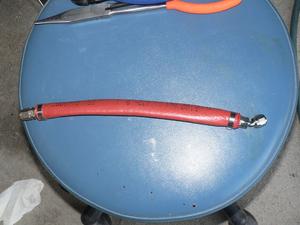I installed the sniffle valve earlier this week, and yesterday I finished installing the drain line from the sniffle valve to the back of the cowling. The sniffle valve allows any fuel that collects in the intake manifold after shutdown, or a flooded start, to drain out.
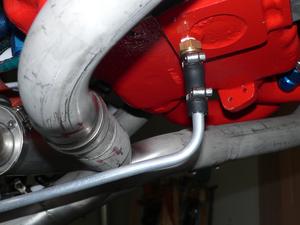 The sniffle valve is designed to have a 3/8" ID flexible rubber hose attached to it. This hose would have to run very close to the exhaust pipes, so I decided to transition to aluminum tubing.
The sniffle valve is designed to have a 3/8" ID flexible rubber hose attached to it. This hose would have to run very close to the exhaust pipes, so I decided to transition to aluminum tubing.
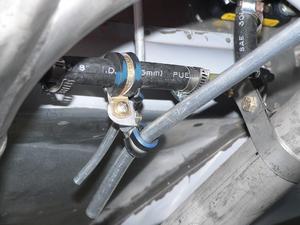 I hung the aft end of the aluminum tubing from the exhaust system hangars.
I hung the aft end of the aluminum tubing from the exhaust system hangars.
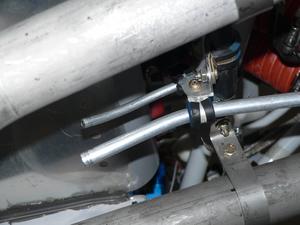 I also attached the drain line from the fuel pump. Normally, this drain line should have no fuel coming from it, but if the diaphragm develops a leak, the fuel needs to be routed to a safe place. I attached the bottom end of that drain line to the same place as the sniffle valve drain was supported. I used a piece of rubber hose between the fuel pump and the aluminum drain line to take care of vibration and the movement of the engine.
I also attached the drain line from the fuel pump. Normally, this drain line should have no fuel coming from it, but if the diaphragm develops a leak, the fuel needs to be routed to a safe place. I attached the bottom end of that drain line to the same place as the sniffle valve drain was supported. I used a piece of rubber hose between the fuel pump and the aluminum drain line to take care of vibration and the movement of the engine.
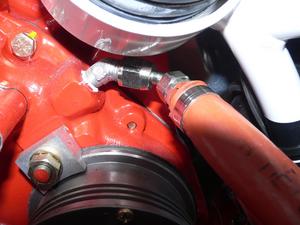 I also replaced the oil pressure line with a piece of Teflon lined hose from Pegasus Auto Racing Supplies. I cut the original hose a tiny bit too short, so there was no slack in the line at all. The movement of the engine on the engine mount would have put very high tension on the line, as the other end as attached to the oil pressure sender on the firewall, and the line would have failed. For the new line, I put a 45° fitting on the end to keep it further away from the engine mount. I decided to go with Teflon lined hose as they have a very long life, whereas the original hose I used is supposed to be replaced every few years. The fittings on the Aeroquip hose from Pegasus assemble very easily - much easier than the fittings on the rubber line hose I purchased from Aircraft Spruce.
I also replaced the oil pressure line with a piece of Teflon lined hose from Pegasus Auto Racing Supplies. I cut the original hose a tiny bit too short, so there was no slack in the line at all. The movement of the engine on the engine mount would have put very high tension on the line, as the other end as attached to the oil pressure sender on the firewall, and the line would have failed. For the new line, I put a 45° fitting on the end to keep it further away from the engine mount. I decided to go with Teflon lined hose as they have a very long life, whereas the original hose I used is supposed to be replaced every few years. The fittings on the Aeroquip hose from Pegasus assemble very easily - much easier than the fittings on the rubber line hose I purchased from Aircraft Spruce.
